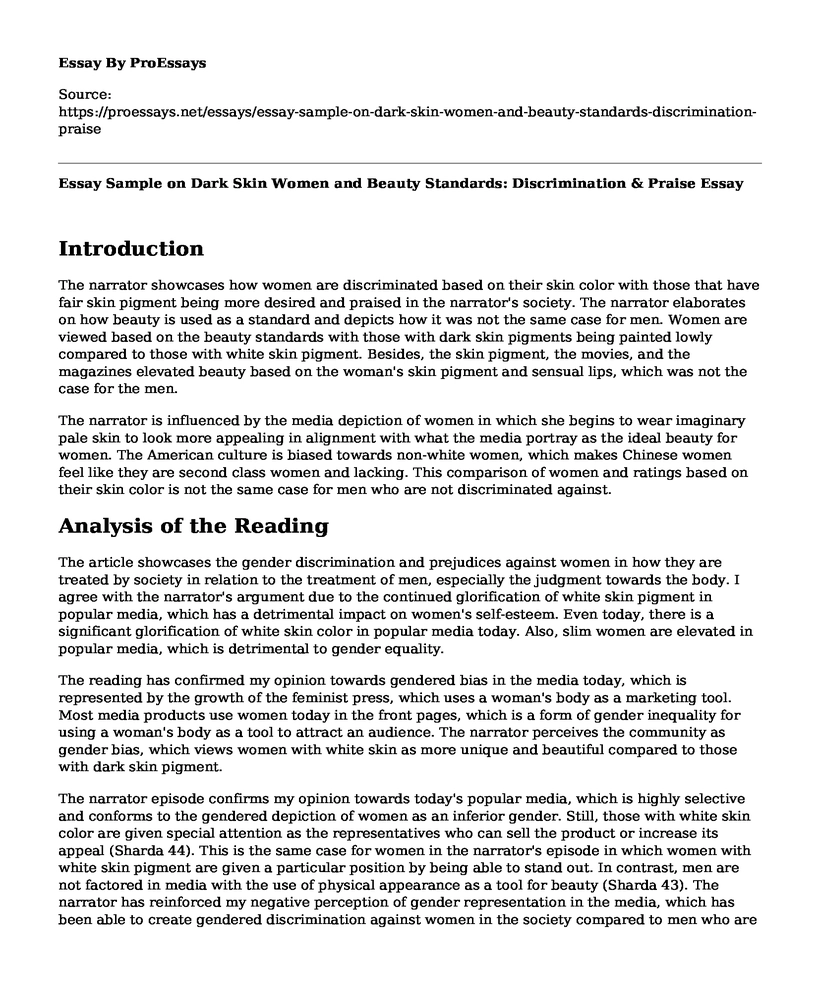Introduction
The narrator showcases how women are discriminated based on their skin color with those that have fair skin pigment being more desired and praised in the narrator's society. The narrator elaborates on how beauty is used as a standard and depicts how it was not the same case for men. Women are viewed based on the beauty standards with those with dark skin pigments being painted lowly compared to those with white skin pigment. Besides, the skin pigment, the movies, and the magazines elevated beauty based on the woman's skin pigment and sensual lips, which was not the case for the men.
The narrator is influenced by the media depiction of women in which she begins to wear imaginary pale skin to look more appealing in alignment with what the media portray as the ideal beauty for women. The American culture is biased towards non-white women, which makes Chinese women feel like they are second class women and lacking. This comparison of women and ratings based on their skin color is not the same case for men who are not discriminated against.
Analysis of the Reading
The article showcases the gender discrimination and prejudices against women in how they are treated by society in relation to the treatment of men, especially the judgment towards the body. I agree with the narrator's argument due to the continued glorification of white skin pigment in popular media, which has a detrimental impact on women's self-esteem. Even today, there is a significant glorification of white skin color in popular media today. Also, slim women are elevated in popular media, which is detrimental to gender equality.
The reading has confirmed my opinion towards gendered bias in the media today, which is represented by the growth of the feminist press, which uses a woman's body as a marketing tool. Most media products use women today in the front pages, which is a form of gender inequality for using a woman's body as a tool to attract an audience. The narrator perceives the community as gender bias, which views women with white skin as more unique and beautiful compared to those with dark skin pigment.
The narrator episode confirms my opinion towards today's popular media, which is highly selective and conforms to the gendered depiction of women as an inferior gender. Still, those with white skin color are given special attention as the representatives who can sell the product or increase its appeal (Sharda 44). This is the same case for women in the narrator's episode in which women with white skin pigment are given a particular position by being able to stand out. In contrast, men are not factored in media with the use of physical appearance as a tool for beauty (Sharda 43). The narrator has reinforced my negative perception of gender representation in the media, which has been able to create gendered discrimination against women in the society compared to men who are immune to traditional bias, which has been detrimental to the development of gender equality and the neutrality of women representation.
"When I was younger, I read magazines and saw movies, blonde movie stars, white skin, and sensuous lips and to be elevated, to become a woman, a desirable woman, I began to wear imaginary pale skin." This quote has drawn significant attention because it depicts the gender insensitivity to women even in the cases where women are in control, and it is a source of sustainable gender discrimination in society.
The Role of Feminism in Fighting for Women Rights
Feminism has been instrumental in reducing gender discrimination in media by giving women a chance to fight to retain their identity without harsh judgment from society. Feminism provides women with a voice to call for equality in pay, to individual determinism, and access to education (Okin 32). Women in media are slowly gained respect, and today they are being recognized, which has reduced the negative identity stereotyping towards appearing in media and other fashion products.
Works Cited
Okin, Susan Moller. "Feminism, women's human rights, and cultural differences." Hypatia 13.2 (1998): 32-52.
Sharda, Adhikari. "Media and gender stereotyping: The need for media literacy." International Research Journal of Social Sciences 3.8 (2014): 43-49.
Cite this page
Essay Sample on Dark Skin Women and Beauty Standards: Discrimination & Praise. (2023, Mar 13). Retrieved from https://proessays.net/essays/essay-sample-on-dark-skin-women-and-beauty-standards-discrimination-praise
If you are the original author of this essay and no longer wish to have it published on the ProEssays website, please click below to request its removal:
- Factors That Enhance Multicultural Communication for Virtue Teams Paper Example
- Left Wing Media Bias Essay Example
- The Community Intervention Strategy Paper Example
- Sweatshops as One of the Main Unethical Practices by Global Businesses - Essay Sample
- Essay Sample on Racial Profiling In Peel Region Ontario
- Communication in the Fire Service Paper Example
- Literary Analysis Essay on The Weight of Shadows







